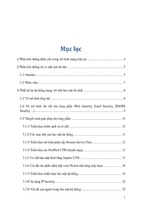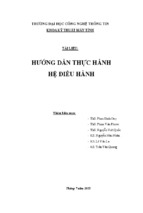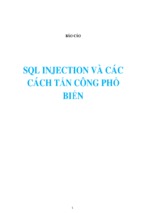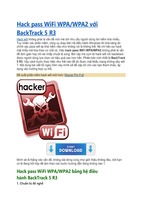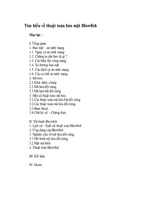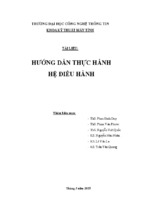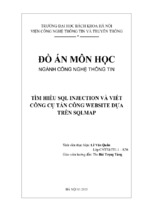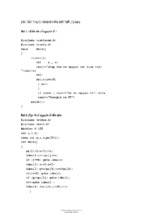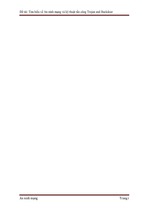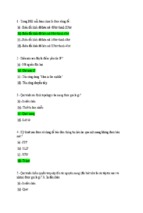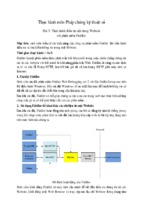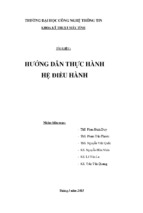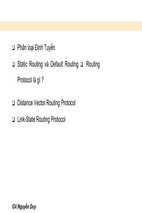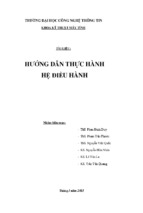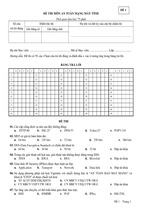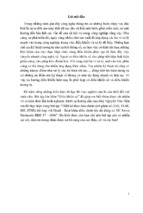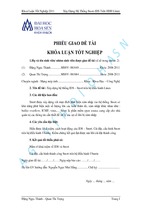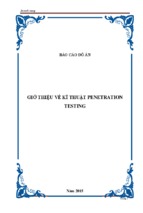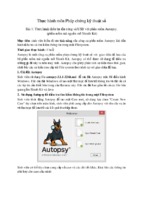WiMAX™, HSPA+, and LTE:
A Comparative Analysis
November 2009
Copyright 2009 WiMAX Forum
“WiMAX,” “WiMAX Forum,” the WiMAX Forum logo, "WiMAX Forum Certified,” and the WiMAX Forum
Certified logo are trademarks of the WiMAX Forum. All other trademarks are the properties of their
respective owners.
________________________________________________________________________
Copyright Notice, Use Restrictions, Disclaimer, and Limitation of Liability
Copyright 2009 WiMAX Forum. All rights reserved.
The WiMAX Forum® owns the copyright in this document and reserves all rights herein.
This document is available for download from the WiMAX Forum and may be
duplicated for internal use, provided that all copies contain all proprietary notices and
disclaimers included herein. Except for the foregoing, this document may not be
duplicated, in whole or in part, or distributed without the express written authorization of
the WiMAX Forum.
Use of this document is subject to the disclaimers and limitations described below. Use
of this document constitutes acceptance of the following terms and conditions:
THIS DOCUMENT IS PROVIDED “AS IS” AND WITHOUT WARRANTY OF
ANY KIND. TO THE GREATEST EXTENT PERMITTED BY LAW, THE
WiMAX FORUM DISCLAIMS ALL EXPRESS, IMPLIED AND STATUTORY
WARRANTIES, INCLUDING, WITHOUT LIMITATION, THE IMPLIED
WARRANTIES OF TITLE, NONINFRINGEMENT, MERCHANTABILITY AND
FITNESS FOR A PARTICULAR PURPOSE. THE WiMAX FORUM DOES NOT
WARRANT THAT THIS DOCUMENT IS COMPLETE OR WITHOUT ERROR
AND DISCLAIMS ANY WARRANTIES TO THE CONTRARY.
Any products or services provided using technology described in or implemented in
connection with this document may be subject to various regulatory controls under the
laws and regulations of various governments worldwide. The user is solely responsible
for the compliance of its products and/or services with any such laws and regulations and
for obtaining any and all required authorizations, permits, or licenses for its products
and/or services as a result of such regulations within the applicable jurisdiction.
NOTHING IN THIS DOCUMENT CREATES ANY WARRANTIES
WHATSOEVER
REGARDING
THE
APPLICABILITY
OR
NONAPPLICABILITY OF ANY SUCH LAWS OR REGULATIONS OR THE
SUITABILITY OR NON-SUITABILITY OF ANY SUCH PRODUCT OR
SERVICE FOR USE IN ANY JURISDICTION.
NOTHING IN THIS DOCUMENT CREATES ANY WARRANTIES
WHATSOEVER REGARDING THE SUITABILITY OR NON-SUITABILITY OF
A PRODUCT OR A SERVICE FOR CERTIFICATION UNDER ANY
CERTIFICATION PROGRAM OF THE WiMAX FORUM OR ANY THIRD
PARTY.
. Copyright 2009 WiMAX Forum
“WiMAX,” “WiMAX Forum,” the WiMAX Forum logo, "WiMAX Forum Certified,” and the WiMAX Forum
Certified logo are trademarks of the WiMAX Forum. All other trademarks are the properties of their
respective owners.
Page 2 of 36
v5.1
________________________________________________________________________
The WiMAX Forum has not investigated or made an independent determination
regarding title or non-infringement of any technologies that may be incorporated,
described or referenced in this document. Use of this document or implementation of any
technologies described or referenced herein may therefore infringe undisclosed thirdparty patent rights or other intellectual property rights. The user is solely responsible for
making all assessments relating to title and non-infringement of any technology,
standard, or specification referenced in this document and for obtaining appropriate
authorization to use such technologies, technologies, standards, and specifications,
including through the payment of any required license fees.
NOTHING IN THIS DOCUMENT CREATES ANY WARRANTIES OF TITLE
OR NONINFRINGEMENT WITH RESPECT TO ANY TECHNOLOGIES,
STANDARDS OR SPECIFICATIONS REFERENCED OR INCORPORATED
INTO THIS DOCUMENT.
IN NO EVENT SHALL THE WiMAX FORUM OR ANY MEMBER BE LIABLE
TO THE USER OR TO A THIRD PARTY FOR ANY CLAIM ARISING FROM
OR RELATING TO THE USE OF THIS DOCUMENT, INCLUDING, WITHOUT
LIMITATION, A CLAIM THAT SUCH USE INFRINGES A THIRD PARTY’S
INTELLECTUAL PROPERTY RIGHTS OR THAT IT FAILS TO COMPLY
WITH APPLICABLE LAWS OR REGULATIONS.
BY USE OF THIS
DOCUMENT, THE USER WAIVES ANY SUCH CLAIM AGAINST THE
WiMAX FORUM AND ITS MEMBERS RELATING TO THE USE OF THIS
DOCUMENT.
The WiMAX Forum reserves the right to modify or amend this document without notice
and in its sole discretion. The user is solely responsible for determining whether this
document has been superseded by a later version or a different document.
“WiMAX,” “Mobile WiMAX,” “Fixed WiMAX,” “WiMAX Forum,” “WiMAX
Certified,” “WiMAX Forum Certified,” the WiMAX Forum logo and the WiMAX
Forum Certified logo are trademarks of the WiMAX Forum. Third-party trademarks
contained in this document are the property of their respective owners.
. Copyright 2009 WiMAX Forum
“WiMAX,” “WiMAX Forum,” the WiMAX Forum logo, "WiMAX Forum Certified,” and the WiMAX Forum
Certified logo are trademarks of the WiMAX Forum. All other trademarks are the properties of their
respective owners.
Page 3 of 36
v5.1
________________________________________________________________________
Author’s Note
Performance of wireless systems is highly dependent on the operating environment,
deployment choices and the end-to-end network implementation. Performance
projections presented in this paper are based on simulations performed with specific
multipath models, usage assumptions, and equipment parameters. In practice, actual
performance may differ due to local propagation conditions, multipath, customer and
applications mix, and hardware choices. The performance numbers presented should not
be relied on as a substitute for equipment field trials and sound RF analysis. They are best
used only as a guide to the relative performance of the different technology and
deployment alternatives reviewed in this paper as opposed to absolute performance
projections.
About the Author
Doug Gray is a Telecommunications Consultant and is currently under contract to the
WiMAX Forum®. Gray has had extensive experience in broadband wireless access
systems in engineering and management positions at Hewlett-Packard, Lucent
Technologies and Ensemble Communications.
Acknowledgements
The author is especially grateful to the team at Intel Corporation for conducting the
WiMAX™ performance simulations and for the many follow on discussions regarding
the presentation of the data. The author would also like to acknowledge the contributions
of the many WiMAX Forum® members who have taken the time to review the paper and
provide comments and insights regarding the contents and the conclusions drawn.
. Copyright 2009 WiMAX Forum
“WiMAX,” “WiMAX Forum,” the WiMAX Forum logo, "WiMAX Forum Certified,” and the WiMAX Forum
Certified logo are trademarks of the WiMAX Forum. All other trademarks are the properties of their
respective owners.
Page 4 of 36
v5.1
________________________________________________________________________
Table of Contents
1. Introduction ..................................................................................................................... 7
2. Planned Air Interface Enhancements for WiMAX ......................................................... 8
2.1 WiMAX Air Interface Release 1.5 ........................................................................... 9
2.1.1 Peak Channel Rate Performance ...................................................................... 11
2.1.2 Average Channel Throughput Performance .................................................... 13
3. 3GPP Evolution: HSPA+ .............................................................................................. 16
3.1 Comparing WiMAX and HSPA+ ........................................................................... 18
4. LTE ............................................................................................................................... 20
4.1 WiMAX and LTE ................................................................................................... 21
5. IMT-Advanced and IEEE 802.16m .............................................................................. 24
5.1 IMT-Advanced ........................................................................................................ 24
5.2 IEEE 802.16m ......................................................................................................... 25
5.3 WiMAX 2 ............................................................................................................... 27
5.3.1 WiMAX Migration Path for DL Peak Channel Data Rates ............................. 27
5.3.2 Backwards Compatibility................................................................................. 28
5.4 LTE-Advanced ........................................................................................................ 29
6. WiMAX has Time-to-Market Advantage ..................................................................... 29
6.1 Migration Path Options for Today’s Mobile Operators .......................................... 30
7. Summary and Conclusion ............................................................................................. 33
Acronyms .......................................................................................................................... 33
References ......................................................................................................................... 36
. Copyright 2009 WiMAX Forum
“WiMAX,” “WiMAX Forum,” the WiMAX Forum logo, "WiMAX Forum Certified,” and the WiMAX Forum
Certified logo are trademarks of the WiMAX Forum. All other trademarks are the properties of their
respective owners.
Page 5 of 36
v5.1
________________________________________________________________________
Figures
Figure 1: WiMAX Peak Data Rate Projections ................................................................ 12
Figure 2: Average Channel/Sector Throughput (TDD) .................................................... 15
Figure 3: Average Channel/Sector Throughput (FDD) .................................................... 15
Figure 4: Simultaneous VoIP Calls per MHz ................................................................... 16
Figure 5: LTE-WiMAX Spectral Efficiency Comparison ................................................ 23
Figure 6: Peak DL Data Rate Migration Path for WiMAX .............................................. 28
Figure 7: Timeline for Mobile WiMAX and 3GPP .......................................................... 30
Figure 8: Migration Paths for Today’s Mobile Operators ................................................ 31
Figure 9: A Sampling of WiMAX Multimode Devices.................................................... 32
Tables
Table 1: Key Features & Enhancements for WiMAX Air Interface R1.5.......................... 9
Table 2: Parameters Assumed for WiMAX Peak Channel Rate Performance ................. 12
Table 3: Parameters Assumptions for Evaluation Methodology ...................................... 13
Table 4: Key Performance Enhancements for HSPA+ ..................................................... 17
Table 5: WiMAX HSPA+ Performance Comparison ....................................................... 18
Table 6: Peak Rate Comparisons for LTE and WiMAX .................................................. 21
Table 7: IMT-Advanced Minimum Requirements for Sector Spectral Efficiency........... 25
Table 8: Summary of Objectives for IEEE 802.16m ........................................................ 26
. Copyright 2009 WiMAX Forum
“WiMAX,” “WiMAX Forum,” the WiMAX Forum logo, "WiMAX Forum Certified,” and the WiMAX Forum
Certified logo are trademarks of the WiMAX Forum. All other trademarks are the properties of their
respective owners.
Page 6 of 36
v5.1
________________________________________________________________________
WiMAX™, HSPA+, and LTE: A Comparative Analysis
1. Introduction
An earlier WiMAX Forum® white paper provided a very detailed description and
performance analysis for WiMAX™ [Ref 1] and a follow-on white paper [Ref 2]
provided a comparative analysis of WiMAX with 3G enhancements, EV-DO through
Rev B and HSPA through 3GPP Rel-6. For WiMAX™ performance projections, both of
those papers assumed a baseline configuration based on the WiMAX Air Interface
Release 1.0 profiles. As was described in the earlier white papers, the WiMAX Release
1.0 system profile represented a subset of the features and functionality supported in the
IEEE 802.16e-2005 Air Interface Standard. In this paper we consider some of the
additional 802.16e-2005 supported features or enhancements for the air interface that
have been approved or are being considered by the WiMAX Forum for inclusion in the
next step in the backwards compatible WiMAX migration path, WiMAX Air Interface
Release 1.5.
In section 2.0 some of the key PHY and MAC layer features for WiMAX Air Interface
Release 1.5 are described. Peak and average channel throughput and VoIP capacity are
shown and compared with WiMAX Air Interface Release 1.0 to provide the reader a view
of the performance advantages achieved with these added features.
Section 3.0 describes the next steps in the 3GPP migration path known as HSPA+ and
described by 3GPP Rel-7 and 3GPP Rel-8. Projected HSPA+ peak rate performance is
then compared to WiMAX.
A description of 3G Long Term Evolution (LTE), also known as E-UTRA, is provided in
Section 4.0. The performance requirements for LTE are defined in 3GPP Rel-8. Section
4.0 also provides a comparison of LTE Rel-8 projected performance with WiMAX. For
these performance comparisons the emphasis is on peak channel data rate and average
channel spectral efficiency, the two metrics most often referred to in describing or
comparing these access technologies. LTE projections most often quoted in the press
assume an FDD configuration with paired 20 MHz channels. Since LTE is also based on
OFDMA and employs similar modulation schemes the projected performance with regard
to these metrics, as expected, is similar under the same deployment conditions. The key
difference between these two radio access solutions is with regard to timing and
commercial availability. OFDM-based WiMAX networks for fixed services have been
commercially deployed since 2006 and OFDMA-based WiMAX systems were first
commercially deployed in 2008. Planned features for WiMAX with Air Interface Release
1.5 provide a straightforward upgrade path for field proven WiMAX systems. LTE on the
. Copyright 2009 WiMAX Forum
“WiMAX,” “WiMAX Forum,” the WiMAX Forum logo, "WiMAX Forum Certified,” and the WiMAX Forum
Certified logo are trademarks of the WiMAX Forum. All other trademarks are the properties of their
respective owners.
Page 7 of 36
v5.1
________________________________________________________________________
other hand is currently in the development and trial phase. Some early adopters of LTE
have announced that deployments will begin as early as 2010.
Section 5.0 provides a forward looking view regarding the next steps for both 3GPP and
WiMAX with a brief description of LTE-Advanced and the IEEE 802.16m amendment to
the 802.16 air interface standard. The 802.16m amendment will be the basis for WiMAX
2. Both LTE-Advanced, based on 3GPP Rel-10 and WiMAX 2 based on IEEE 802.16m
are projected to meet IMT-Advanced requirements.
A timeline comparison for LTE and WiMAX is presented in Section 6.0. OFDMA-based
WiMAX is field-proven, whereas LTE has yet to be commercially deployed. This clearly
gives WiMAX a time-to-market advantage over LTE for either Greenfield or existing
mobile operators. For existing mobile operators the challenges and costs of upgrading to
WiMAX now or LTE later are similar. With the ability to reuse a considerable portion of
the existing network infrastructure present day mobile operators can cost-effectively gain
a considerable competitive advantage by deploying a WiMAX overlay to an existing
mobile network today rather than waiting for LTE.
Unless otherwise noted, references to LTE in this paper will be with respect to LTE as
defined by 3GPP Rel-8.
2. Planned Air Interface Enhancements for WiMAX
The first commercial OFDM-based WiMAX deployments based on the IEEE 802.162004 air interface standard occurred in 2006. Providing services for fixed, nomadic, or
portable services, WiMAX quickly gained market acceptance as an alternative to
broadband fixed wireline services. Since then the 802.16e-2005 amendment to the IEEE
802.16 air interface standard with the addition of OFDMA and other key features added
mobility to the supported WiMAX usage models. Certified WiMAX products based on
the 802.16e-2005 amendment have been commercially available since 2008. As of mid
2009 more than 130 products have received WiMAX certification and over 60% of these
are Mobile WiMAX certified. There are now more than 500 WiMAX deployments
currently underway serving a range of usage models from fixed to mobile services in
more than 140 countries1.
To further improve on the performance and features of WiMAX, the WiMAX Forum has
completed and approved a portfolio of air interface enhancements [Ref 3]. Among the
additional supported features are many air interface related enhancements that directly
1
Information on product certifications and deployments is updated regularly and available on the WiMAX
Forum website.
. Copyright 2009 WiMAX Forum
“WiMAX,” “WiMAX Forum,” the WiMAX Forum logo, "WiMAX Forum Certified,” and the WiMAX Forum
Certified logo are trademarks of the WiMAX Forum. All other trademarks are the properties of their
respective owners.
Page 8 of 36
v5.1
________________________________________________________________________
impact peak channel data rate and average channel and sector throughput. These are the
metrics most often referenced in the discussion and comparison of different wireless
access technologies and will be used in this paper to compare WiMAX with HSPA+ and
LTE. A number of new frequency profiles and frequency division duplex (FDD) are also
included with these enhancements. The new profiles address new spectrum allocations
being made available by local regulators and FDD further expands the applicability of
WiMAX into markets that have regulatory constraints on the use of TDD. FDD also
gives operators added deployment flexibility where there are no such regulatory
constraints and spectrum licenses are configured in paired channels.
2.1 WiMAX Air Interface Release 1.5
The air interface enhancements approved for WiMAX, designated as WiMAX Air
Interface Release 1.5 (aka Air Interface R1.5), are scheduled for certification testing
readiness in 2010. A more detailed description can be found in reference 3.
A summary of key PHY and MAC features or enhancements planned for Air Interface
R1.5 are summarized in the following table:
Table 1: Key Features & Enhancements for WiMAX Air Interface R1.5
PHY/MAC Feature
Description
Duplex
Support for Frequency Division Duplex (FDD) and Half
Duplex FDD for increased deployment flexibility when
spectrum licenses comprise paired channels.
20 MHz Channel BW
20 MHz added as an optional channel BW in the 17102170 MHz band.
AMC Permutation
Adjacent Multi-carrier (AMC) provides more efficient
sub-carrier utilization compared to PUSC in low mobility
situations translating to higher peak data rate and higher
average channel throughput.
. Copyright 2009 WiMAX Forum
“WiMAX,” “WiMAX Forum,” the WiMAX Forum logo, "WiMAX Forum Certified,” and the WiMAX Forum
Certified logo are trademarks of the WiMAX Forum. All other trademarks are the properties of their
respective owners.
Page 9 of 36
v5.1
________________________________________________________________________
PHY/MAC Feature
MIMO Enhancements
Description
Downlink open and closed loop MIMO with AMC
permutation.
UL collaborative spatial multiplexing (SM) for two MSs
in AMC mode.
UL open loop STC/SM MIMO in AMC and PUSC mode
Cyclic delay diversity
MAC Efficiency
Enhancements
DL and UL Persistent Allocation of Information Elements
(IE’s) for reduced MAP overhead with both persistent and
non-persistent traffic.
Handover
Enhancements
Improved efficiency with seamless handover
Load Balancing
Load Balancing using preamble index and/or DL
frequency override
Load Balancing using ranging abort timer
Load Balancing using BS initiated handover
Location Based Services
(LBS)
GPS-based LBS method
Assisted GPS (A-GPS) method
Non-GPS-based method
Enhanced Multicast &
Broadcast Services
(MBS)
Optimization/Clarification to MBS procedures such as
group DSx and inter-MBS zone continuity messages
WiMAX-WiFi-Bluetooth
Coexistence
Co-located coexistence Mode 1
Co-located coexistence Mode 2
Combine UL band AMC with operation with co-located
coexistence
WiMAX Air Interface R1.5 also introduces several new TDD and FDD frequency
profiles to address changing global spectrum allocations. Among the added profiles
provided, coverage in the 698 to 862 MHz band is especially interesting in that it holds
. Copyright 2009 WiMAX Forum
“WiMAX,” “WiMAX Forum,” the WiMAX Forum logo, "WiMAX Forum Certified,” and the WiMAX Forum
Certified logo are trademarks of the WiMAX Forum. All other trademarks are the properties of their
respective owners.
Page 10 of 36
v5.1
________________________________________________________________________
the promise of helping to bridge the digital divide in both developed and developing
markets [Ref 4, 5]. Wireless access solutions in these lower frequency bands can provide
a significant range and coverage advantage compared to allocations in the higher bands
[Ref 6, 7]. As these lower bands become more widely available worldwide, the business
case will be greatly enhanced for rural area deployments. Additionally, portions of these
lower frequency bands are designated for public safety services, another important
application well-suited to WiMAX. Profiles in the 1710 to 2170 MHz range, including
the AWS (Advanced Wireless Services) band have also been added with Air Interface
R1.5. This is one of the bands considered suitable for support of 20 MHz channel BW.
2.1.1 Peak Channel Rate Performance
The peak channel rate or peak user rate performance is a metric most often quoted in the
comparison of varied access technologies. This is despite the fact that this data rate is
only attainable in a limited portion of the cell coverage area where propagation
conditions are sufficient to support the highest efficiency modulation scheme with
minimal channel coding rate. Nevertheless, it is still an important metric for comparative
purposes since it does reflect the best attainable channel performance and user
experience. It is also directly proportional to the average channel throughput which, for
deployment considerations, is a much more important performance metric.
Table 2 summarizes the parameter assumptions used for the peak channel rate
performance for both Air Interface R1.0 and R1.5. Although (2x2) MIMO is also
supported in the UL, (1x2) SIMO is assumed in this and following examples to represent
a baseline mobile station (MS) configuration. In the UL, 16QAM is a mandatory feature
with both Air Interface R1.0 and R1.5 whereas 64QAM is optional. In Table 2, 64QAM
with 5/6 coding rate is assumed for both Air Interface R1.0 and R1.5. The modulation
and coding rate difference alone provides a net increase of 66% in the UL data rate. The
use of AMC vs. PUSC provides the additional improvement in UL peak data rate.
The results for the peak channel data rate are shown graphically in Figure 1. The
projections for TDD assume a DL to UL ratio of 29:182 (approximately 3:2).
2
In TDD mode Mobile WiMAX can adapt to a DL to UL ratio ranging from 1:1 to 3:1.
. Copyright 2009 WiMAX Forum
“WiMAX,” “WiMAX Forum,” the WiMAX Forum logo, "WiMAX Forum Certified,” and the WiMAX Forum
Certified logo are trademarks of the WiMAX Forum. All other trademarks are the properties of their
respective owners.
Page 11 of 36
v5.1
________________________________________________________________________
Table 2: Parameters Assumed for WiMAX Peak Channel Rate Performance
WiMAX
Air Interface R1.0
Duplex
Channel BW
Downlink
Air Interface R1.5
TDD
TDD
FDD
10 MHz
10 MHz
2 x 10 MHz &
2 x 20 MHz
(2x2) SU-MIMO
(2x2) SU-MIMO
(1x2) SIMO
(1x2) SIMO
PUSC
AMC
Uplink
Permutation
DL OH Symbols
3
3
3
DL Data Symbols
26
26
45
DL Modulation
64QAM
64QAM
DL FEC Coding
5/6
5/6
UL OH Symbols
3
3
UL Data Symbols
15
15
45
64QAM
64QAM
UL FEC Coding
5/6
5/6
Peak Channel Data Rate
Peak Channel Spectral Efficiency
DL/UL ~3:2 for TDD
DL/UL ~3:2 for TDD
.
160
140
120
100
80
60
40
20
0
DL
UL
10 MHz
TDD
Air Interface
R1.0
10 MHz
20 MHz
2x10 MHz
TDD
Bits/Sec/Hz
Mbps
.
UL Modulation
8.0
7.0
6.0
5.0
4.0
3.0
2.0
1.0
0.0
2x20 MHz
FDD
DL
UL
10 MHz
TDD
Air Interface R1.5
Air Interface
R1.0
10 MHz
20 MHz
2x10 MHz
TDD
2x20 MHz
FDD
Air Interface R1.5
Figure 1: WiMAX Peak Data Rate Projections
.
. Copyright 2009 WiMAX Forum
“WiMAX,” “WiMAX Forum,” the WiMAX Forum logo, "WiMAX Forum Certified,” and the WiMAX Forum
Certified logo are trademarks of the WiMAX Forum. All other trademarks are the properties of their
respective owners.
Page 12 of 36
v5.1
________________________________________________________________________
2.1.2 Average Channel Throughput Performance
Average channel or sector throughput performance provides a measure of the channel or
sector capacity in a simulated multi-cellular deployment with multiple active users.
Throughput performance is especially important in capacity-constrained deployments,
typically encountered in high density urban environments. This parameter has a direct
impact on the required base station to base station spacing necessary to satisfactorily
meet peak busy hour capacity demands.
Evaluation Methodology
The evaluation methodology used for estimating throughput performance is similar to the
methodology proposed by the NGMN Alliance [Ref 8] and the IEEE [Ref 9]. It is also
consistent with the methodology being used for LTE Rel-8 simulations. The current
methodology differs from the 1xEV-DV methodology [Ref 10] used in the past by
3GPP/3GPP2 and in earlier WiMAX Forum papers [Ref 1, 2]. The reader is cautioned
therefore not to try to directly compare the results presented here with earlier results
reported for WiMAX. The following table summarizes the key parameters used for the
most recent simulations3.
Table 3: Parameters Assumptions for Evaluation Methodology
Parameters
Values
Number of Base Stations in Cluster
19
Sectors per Base Station
3
Operating Frequency
2500 MHz
Frequency Reuse
1
TDD
FDD
10 & 20 MHz
2 x 10 & 2 x20 MHz
Duplex
Channel Bandwidth
BS-to-BS Distance
Antenna Pattern
0.5 kilometers
70° (-3 dB) with 20 dB front-to-back ratio
Base Station Antenna Height
12 meters
Mobile Terminal Height
1.5 meters
BS Antenna Gain
3
15 dBi
Simulation results were provided by Intel Corporation
. Copyright 2009 WiMAX Forum
“WiMAX,” “WiMAX Forum,” the WiMAX Forum logo, "WiMAX Forum Certified,” and the WiMAX Forum
Certified logo are trademarks of the WiMAX Forum. All other trademarks are the properties of their
respective owners.
Page 13 of 36
v5.1
________________________________________________________________________
Parameters
Values
MS Antenna Gain
-1 dBi
BS Maximum PA Power
43 dBm
Mobile Terminal Maximum PA Power
# of BS Tx/Rx Antenna
# of MS Tx/Rx Antenna
23 dBm
Tx: 2; Rx: 2 [(2x2) MIMO)] &
Tx: 4, Rx: 2 [(4x2) MIMO] for Release 1.5
Tx: 1; Rx: 2 [(1x2) SIMO]
BS Noise Figure
4 dB
MS Noise Figure
7 dB
I + 37.6 x Log(d)
[d in km, I = 130.62 for 2500 MHz]
Path Loss Model
Log-Normal Shadowing Std Dev
8 dB
BS Shadowing Correlation
0.5
Penetration Loss
20 dB
Traffic
Full Buffer Data Traffic
Number of Users
30 per BS (10 per Sector)
Mobility
SCM with 3 km per Hour
Sector/Channel Throughput and Spectral Efficiency
Figure 2 provides a summary of the simulation results for TDD channel throughput and
spectral efficiency for WiMAX with Air Interface R1.0 and R1.5. The DL to UL ratio is
assumed to be approximately 3:2. The planned Air Interface R1.5 enhancements provide
greater than 20% increase in DL average channel throughput.
. Copyright 2009 WiMAX Forum
“WiMAX,” “WiMAX Forum,” the WiMAX Forum logo, "WiMAX Forum Certified,” and the WiMAX Forum
Certified logo are trademarks of the WiMAX Forum. All other trademarks are the properties of their
respective owners.
Page 14 of 36
v5.1
________________________________________________________________________
Average Sector/Channel Throughput (TDD)
Average Spectral Efficiency (TDD)
DL/UL Ratio ~3:2
DL/UL Ratio ~3:2
2.5
.
30
25
Mbps
DL
15
UL
10
bps per Hz
.
2.0
20
5
0
1.5
DL
1.0
UL
0.5
0.0
10 MHz
2x2 MIMO
10 MHz
20 MHz
10 MHz
2x2 MIMO
Air Interface
R1.0
20 MHz
10 MHz
4x2 MIMO
2x2 MIMO
Air Interface R1.5
10 MHz
20 MHz
10 MHz
2x2 MIMO
Air Interface
R1.0
20 MHz
4x2 MIMO
Air Interface R1.5
Figure 2: Average Channel/Sector Throughput (TDD)
The average channel or sector throughput and average spectral efficiency for FDD
profiles with WiMAX is shown in Figure 3.
.
Average Spectral Efficiency (FDD)
2.5
.
45
40
35
30
25
20
15
10
5
0
2.0
DL
UL
bps per Hz
Mbps
.
Average Channel/Sector Throughput (FDD)
1.5
DL
1.0
UL
0.5
0.0
2x10 MHz
2x10 MHz
2x20 MHz
2x20 MHz
2x10 MHz
2x10 MHz
2x20 MHz
2x20 MHz
2x2 MIMO
4x2 MIMO
2x2 MIMO
4x2 MIMO
2x2 MIMO
4x2 MIMO
2x2 MIMO
4x2 MIMO
Air Interface R1.5
Air Interface R1.5
Figure 3: Average Channel/Sector Throughput (FDD)
VoIP Capacity
WiMAX Air Interface R1.0 has a VoIP capacity of 30 simultaneous VoIP sessions per
MHz per sector assuming an AMR 12.2 kps speech CODEC4. For the same duplex
method and channel BW with persistent scheduling and the other planned enhancements,
the VoIP capacity is increased by more than 40% with Air Interface R1.5. With TDD and
(2x2) MIMO the net VoIP capacity for a 10 MHz channel BW is approximately 215
simultaneous sessions for Air Interface R1.5. This compares to 150 VoIP sessions for Air
Interface R1.0.
4
The VoIP efficiency would be approximately 50% higher with EVRC 7.95 kbps
. Copyright 2009 WiMAX Forum
“WiMAX,” “WiMAX Forum,” the WiMAX Forum logo, "WiMAX Forum Certified,” and the WiMAX Forum
Certified logo are trademarks of the WiMAX Forum. All other trademarks are the properties of their
respective owners.
Page 15 of 36
v5.1
________________________________________________________________________
VoIP Capacity
43
45
2x2 MIMO
4x2 MIMO
30
0
2x2 MIMO
TDD
TDD/FDD
Air Interface R1.0
Air Interface R1.5
Figure 4: Simultaneous VoIP Calls per MHz
3. 3GPP Evolution: HSPA+
HSPA+ also referred to as HSPA Evolved is a further 3GPP enhancement to HSPA Rel6. HSPA Rel-6 has been available as a WCDMA upgrade to 3G operators since 2007.
HSPA Rel-6 supports a peak theoretical DL data rate of 14 Mbps and a peak theoretical
UL data rate of 5.8 Mbps assuming no channel coding for error correction. HSPA+
provides an increase in both the DL and UL modulation efficiency as well as support for
(2x2) MIMO at the base station. HSPA 3GPP Rel-7 supports 64QAM in the DL and
16QAM in the UL. Rel-7 also provides support for (2x2) MIMO in the DL. This DL
feature however, is not supported simultaneously with 64QAM.
HSPA Rel-8 provides simultaneous support for 64QAM and (2x2) MIMO in the DL and
adds the capability for dual carrier support [Ref 11, 12]. This feature, referred to as Dual
Cell or Dual Carrier HSDPA (DC-HSDPA) enables the aggregation of two adjacent 5
MHz channels to provide the equivalent DL peak rate capability of a 10 MHz channel.
DC-HSDPA is not supported with (2x2) MIMO but provides operators that have access
to adjacent paired 5 MHz channels to get the equivalent peak performance without
having to upgrade to a more advanced antenna system at the base station. This, in most
cases, will represent a more cost-effective migration path for the operator since it does
not necessitate a truck-roll to implement the base station antenna upgrade.
Theoretical peak DL rates reported for HSPA+ without error correction are 28 Mbps for
Rel-7 and 42 Mbps for Rel-8. Theoretical peak UL rate without error correction is 11
. Copyright 2009 WiMAX Forum
“WiMAX,” “WiMAX Forum,” the WiMAX Forum logo, "WiMAX Forum Certified,” and the WiMAX Forum
Certified logo are trademarks of the WiMAX Forum. All other trademarks are the properties of their
respective owners.
Page 16 of 36
v5.1
________________________________________________________________________
Mbps. Other performance enhancements in HSPA Rel-7 and Rel-8 include increased
VoIP capacity, reduced latency, and reduced UE battery consumption [Ref. 13].
Further enhancements being considered for HSPA in 3GPP Rel-9 include multi-carrier
support for the aggregation of more DL channels, possibly up to four, without the
requirement that the channels be contiguous. Another performance enhancement being
considered for Rel-9 is dual carrier support in the UL to theoretically double UL peak
rate performance over what is available with 3GPP Rel-8.
Since HSPA+ enhancements are backwards compatible with 3GPP Rel-5 and 3GPP Rel6 it represents a relatively straightforward migration path for WCDMA operators to
further increase key performance attributes in the access network. To take full advantage
of the increased base station capacity another necessary network upgrade that must be
taken into account is the need for additional capacity in the backhaul network. The cost
for the required hardware upgrades to user devices must also be considered.
The following table provides a summary of key air interface enhancements for 3GPP Rel7 and Rel-8 compared to HSPA defined by 3GPP Rel-6. Enhancements being considered
for HSPA in 3GPP Rel-9 are not included in this table since this release is still in the
study phase.
Table 4: Key Performance Enhancements for HSPA+
HSPA
Parameter
Channel BW
Duplex
DL Modulation and
BS Antenna
HSPA+ (HSPA Evolved)
3GPP Rel-6
3GPP Rel-7
3GPP Rel-8
5 MHz
5 MHz
5 MHz or 2
Contiguous 5 MHz
Channels with DCHSDPA
FDD
FDD
Up to 16QAM with
(1x2) SIMO
Up to 64QAM with
(1x2) SIMO or
Up to 16QAM with
(2x2) MIMO
Up to 64QAM with
(2x2) MIMO or
DC-HSDPA with
(1x2) SIMO
UL Modulation
Up to QPSK
Up to 16QAM
MS Antenna
(1x2) SIMO
(1x2) SIMO
. Copyright 2009 WiMAX Forum
“WiMAX,” “WiMAX Forum,” the WiMAX Forum logo, "WiMAX Forum Certified,” and the WiMAX Forum
Certified logo are trademarks of the WiMAX Forum. All other trademarks are the properties of their
respective owners.
Page 17 of 36
v5.1
________________________________________________________________________
3.1 Comparing WiMAX and HSPA+
In an earlier white paper published by the WiMAX Forum [Ref. 2] a detailed analysis
compared a baseline WiMAX Air Interface R1.0 configuration with 3GPP releases
through HSPA Rel-6. This analysis showed that WiMAX had a higher DL and UL peak
data rate and an average sector throughput that is 2 to 3 times higher than HSPA Rel-6.
The throughput analysis in this case was based on simulations following the
recommended 1xEV-DV methodology [Ref. 14].
Table 5 provides a summary of the peak rate comparisons for HSPA+ and WiMAX Air
Interface R1.5. The peak rate projections for HSPA+ are stated with 3/4 and 5/6 coding
rate for 16QAM and 64QAM respectively. This represents a more realistic deployment
scenario and enables a direct comparison with WiMAX. For reference the values for
HSPA+ with no error correction coding are listed in italics. To provide a direct
comparison a WiMAX Air Interface R1.5 FDD solution is shown with paired 5 MHz
channels. Also included for completeness is a WiMAX TDD solution with the same
amount of occupied spectrum.
Table 5: WiMAX HSPA+ Performance Comparison
HSPA
Parameter
Rel-7
Duplexing
Channel BW
BS Antenna
(1x2)SIMO
MS Antenna
DL Mod-Coding
DL Peak User
Rate
FDD
FDD
TDD
2 x 5 MHz
2 x 5 MHz
10 MHz
(2x2)MIMO
(1x2)SIMO
(2x2)MIMO
(1x2)SIMO
64QAM5/6
16QAM3/4
64QAM5/6
17.5 Mbps
21 Mbps
35 Mbps
(21 Mbps
w/o coding)
(28 Mbps
w/o coding)
(42 Mbps
w/o coding)
UL Mod-Coding
5
Rel-8
WiMAX
Air Interface R1.5
16QAM-3/4
64QAM-5/6
35.3 Mbps
39.9 Mbps5
64QAM5/6
64QAM5/6
Assumes a DL to UL ratio of ~3:2
. Copyright 2009 WiMAX Forum
“WiMAX,” “WiMAX Forum,” the WiMAX Forum logo, "WiMAX Forum Certified,” and the WiMAX Forum
Certified logo are trademarks of the WiMAX Forum. All other trademarks are the properties of their
respective owners.
Page 18 of 36
v5.1
________________________________________________________________________
HSPA
Parameter
UL Peak User
Rate
Rel-7
Rel-8
8.3 Mbps
WiMAX
Air Interface R1.5
17.3 Mbps
11.5 Mbps6
(11 Mbps w/o coding)
As expected, the peak DL user rate for HSPA+ and WiMAX is similar since they are
both based on the same modulation and coding and assume a comparable spectrum
assignment of 10 MHz. The UL difference is attributable to the different modulation
efficiencies for 16QAM (for HSPA+) vs. 64QAM and the difference in coding rate. The
peak DL and UL data rate for WiMAX with TDD is shown for an assumed DL to UL
ratio of approximately 3:2. Note that the table refers to peak user rate not channel rate;
with UL collaborative MIMO, the peak channel rate for WiMAX in the UL is 34.6 Mbps
and 23.0 Mbps respectively for FDD with paired 5 MHz channels and TDD with a 10
MHz channel.
For a more complete comparative analysis between HSPA+ and WiMAX other
performance factors must also be taken into account. WiMAX has many other attributes
that sets it apart from HSPA+. Namely:
Both WiMAX Air Interface R1.0 and R1.5 have higher average spectral efficiency than
HSPA Rel-8 since the benefit of (2x2) MIMO with CDMA provides only a modest
increase of about 20% in spectral efficiency whereas with OFDMA the increase is in
the order of 60% [Ref 2]. (4x2) MIMO is also supported with WiMAX Air Interface
R1.5 to provide a further increase in average spectral efficiency as shown in Figures 2
and 3.
WiMAX Air Interface R1.0 supports channel BWs up to 10 MHz and R1.5 up to 20
MHz whereas HSPA+ is constrained to 5 MHz channel plans to comply with existing
3G WCDMA spectrum assignments. 3GPP Rel-8 does support the aggregation of 2
contiguous 5 MHz channels and 3GPP Rel-9 is considering further channel aggregation
without the need for the channels to be contiguous but HSPA is still tied to a 2x5 MHz
channel plan.
WiMAX is based on an all-IP network architecture. Although HSPA+ is evolving
towards an IP network it is still tied to a circuit-switched legacy network optimized for
voice.
6
Assumes a DL to UL ratio of ~3:2
. Copyright 2009 WiMAX Forum
“WiMAX,” “WiMAX Forum,” the WiMAX Forum logo, "WiMAX Forum Certified,” and the WiMAX Forum
Certified logo are trademarks of the WiMAX Forum. All other trademarks are the properties of their
respective owners.
Page 19 of 36
v5.1
________________________________________________________________________
HSPA+ is still based on CDMA with its inherent limitations [Ref 2] whereas WiMAX
is OFDMA-based with its advantages for:
o High tolerance to multipath and self-interference
o Scalable channel BW
o Orthogonal uplink multiple access for reduced interference between
multiple users
o Frequency selective scheduling
o Fractional frequency reuse
Although HSPA+ enables WCDMA 3G operators to gain a performance improvement
over HSPA Rel-6 and provides a DL peak performance comparable to WiMAX and LTE,
WiMAX offers today’s operators the opportunity to overlay an existing network with a
next generation access network based on OFDMA.
4. LTE
Long Term Evolution (LTE) also referred to as Enhanced-UTRA (E-UTRA) was
initiated in 2004 with the purpose of defining the next phase in the 3GPP migration path.
The LTE specification requirements were initially defined in 3GPP Rel-8 with further
enhancements provided in 3GPP Rel-9. With LTE, 3GPP transitions from CDMA in the
DL to OFDMA. In the UL LTE employs Single-Carrier FDMA (SC-FDMA).
Some of the key performance goals initially established by 3GPP for LTE are:
Peak DL Data Rate:
100 Mbps for 20 MHz channel BW and (2x2)
MIMO BS, Peak DL efficiency of 5 bps/Hz.
Peak UL Data Rate:
50 Mbps for a 20 MHz channel BW and (1x2) SIMO
MS, Peak UL efficiency of 2.5 bps/Hz.
Average DL Throughput:
3 to 4 times HSDPA (3GPP Rel-6) at pedestrian
speed
Average UL Throughput:
2 to 3 times HSUPA (3GPP Rel-6) at pedestrian
speed
Channel BW:
Scalable channel BW to 20 MHz (in contrast with
fixed 5 MHz channels for UTRA)
. Copyright 2009 WiMAX Forum
“WiMAX,” “WiMAX Forum,” the WiMAX Forum logo, "WiMAX Forum Certified,” and the WiMAX Forum
Certified logo are trademarks of the WiMAX Forum. All other trademarks are the properties of their
respective owners.
Page 20 of 36
v5.1
- Xem thêm -

